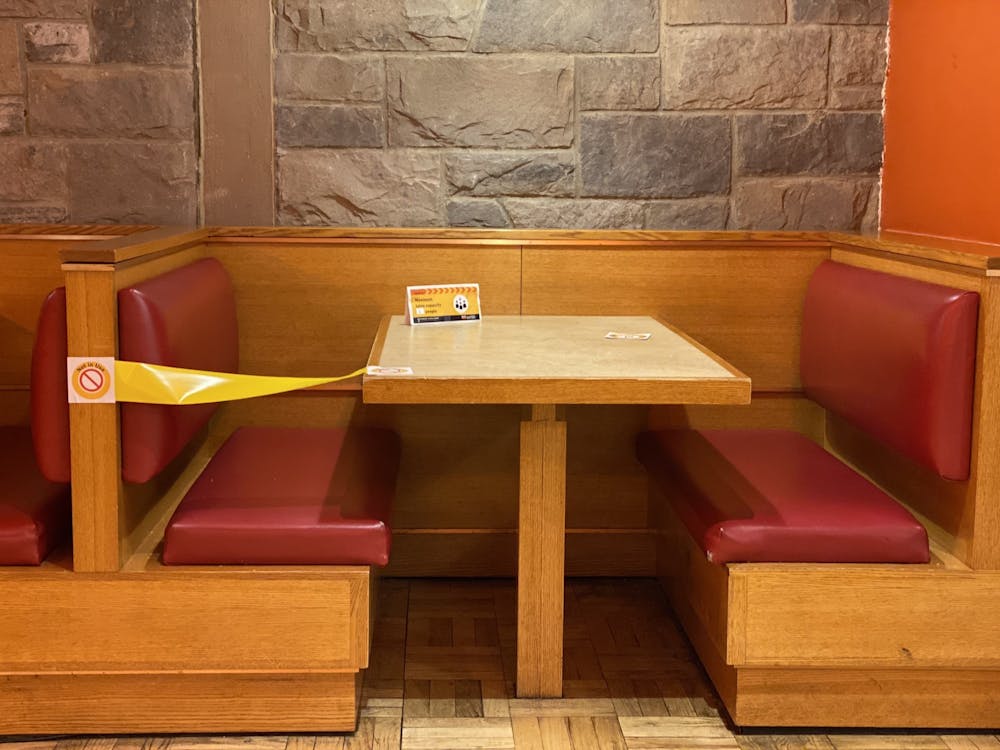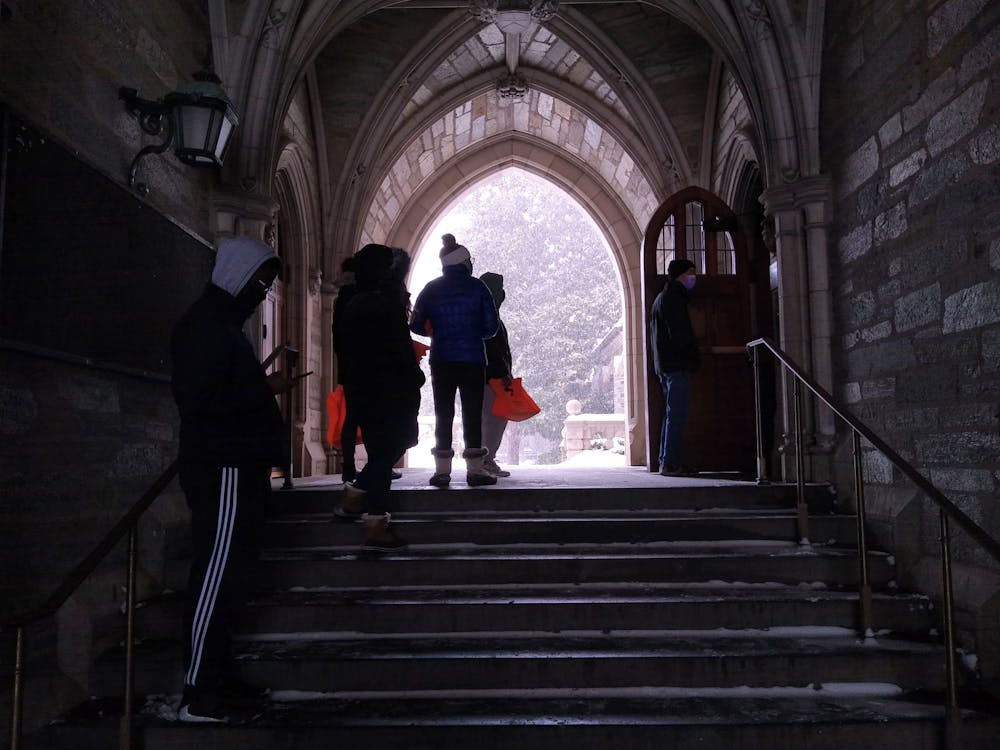Seeking to comply with University COVID-19 safety regulations and the need for social distancing, Campus Dining has changed its offerings considerably since last March, evoking mixed reviews from the student body.
With over 2,800 students living on campus in socially-distant quarters and the closure of all eating clubs and food co-ops, COVID-19 has forced administrators to rethink how the University handles nutrition.
“Health and well-being has always been our guiding principle,” said Smitha Haneef, assistant vice president for Campus Dining, in an interview for another Daily Princetonian article.
On Feb. 1, after all on-campus undergraduates moved in, the University began permitting students to dine at any of the four residential college dining halls or the Center for Jewish Life, with Campus Dining adding limited pickup options at Cafe Vivian earlier this week. However, the dining experience itself has changed greatly.
“The staff of Campus Dining has worked tirelessly to reimagine all aspects of its operations — from food production to packaging, service, and sanitation — to comply with state requirements, public health guidance and University policies around COVID-19,” Deputy University Spokesperson Michael Hotchkiss wrote in an email to the ‘Prince’.
The above facilities all offer virtually the same menu, and students no longer hand their student ID card to a dining worker upon entry — instead swiping themselves in while the employee looks on from behind a plexiglass wall. Dining halls have heavily limited their indoor dining capacity, allowing just 1-3 students per table to sit and eat at places which are cleaned after every use. Upon entering the servery, students choose between a meat entree and a vegan entree, with mostly predetermined sides and extras.

A booth in Wilcox Hall with a maximum capacity of one due to social distancing guidelines.
Zachary Shevin / The Daily Princetonian
Students described the differences in dining services compared to past semesters.

“You just kinda come up and you take a vegetarian or a meat box,” Rish Deshide ’23 said to the ‘Prince.’ “There’s usually a side of soup, there’s water, juice, stuff like that. All the meals are very repetitive.”
According to Hotchkiss, meals are scheduled on a “three-week cycle menu” as chefs took into consideration “production square footage; equipment available in each unit; servery layouts designed for students to serve themselves; and the need to keep staff members socially distant while performing their job responsibilities.”
“Given these factors, the offerings available to students are more limited than during a normal semester, and the same menus are available across all of the residential dining halls,“ he continued.
A number of other students echoed Deshide’s sentiments. While many individuals who spoke with the ‘Prince’ offered praise for servers, janitors, and other employees in the dining halls, many viewed the current food offerings themselves as worse than in years past.

“My roommate and I — both of us are vegetarians — we continued to notice that the meals that we were being served and the offerings that were available in the dining hall were very repetitive [and] lacked flavor,” Harshini Abbaraju ’22 said. “The portion sizes, particularly with regards to the protein options, were really small, and I personally noticed myself feeling really tired, feeling really irritable, like more than usual.”
Abbaraju, a vegetarian for religious reasons, is the author of a petition addressed to Haneef. The document, which contains over 320 signatures at the time of publication, asks “that Campus Dining work to provide more robust dining options for all students on the meal plan, including vegan and vegetarian students.”
Pooja Parmar ’22, a vegan for environmental and animal welfare reasons, described the meals as “definitely hit or miss,” but said they outweighed her expectations. In terms of protein, she says she’s eaten primarily beans, tofu dishes, tempeh, lentils, and seitan — though she particularly enjoyed the Beyond Burgers recently available at the CJL.
“Of course, we would all love more variety and options, but my meals have been nutritious and have kept me full,” Parmar told the ‘Prince.’
Hotchkiss responded to vegetarian student concerns by stating that Campus Dining chefs are working to add new plant-based protein sources to the menu and decrease the number of recipes containing tofu.
“They are currently writing recipes to be added to the menu cycle,” he wrote. “New plant-based proteins will include falafel, vegan meatballs, and meatless veggie crumbles to be incorporated into our vegetarian chili to increase protein content.”
Beyond vegans and vegetarians, students who abide by kosher or halal dietary restrictions — customs of Judaism and Islam, respectively — face other nutritional challenges.
For Jewish students, the process is relatively straightforward. Exclusively serving kosher meals, the CJL serves as a dining hall in addition to its functions as a cultural and religious building.
Hadar Halivni ’22, a denominationally Conservative Jew, has been pleased with the CJL’s offerings, noting that she eats all of her meals in the building and that it offers expanded indoor dining options on Shabbat.
“The food quality actually has been pretty good,” she said. “They’ve been serving a lot of their normal meals. I’m a pretty big meat-eater myself, so we’ve had a lot of chicken which has been wonderful for me. I really like that.”
In contrast to Halivni’s experience, Muskan Effendi ’24, a Muslim student who eats halal, has faced struggles. Primarily eating in residential college dining halls, Effendi remembers instances in which meat was inaccurately labelled as halal and times at which staff misunderstood her observance.
“Sometimes I would ask someone, you know, ‘Is this food halal?’ And they would reply ‘No, it’s chicken.’ And for me that was a little confusing because I felt like I had to educate and I don’t mind doing that, but I feel it should be easier for the Muslim population to just walk in and feel like they’re also seen.”
As the Diversity and Equity Chair in the Undergraduate Student Government Senate, Effendi sits on the dining and nutrition task force, pursuing student-led reforms to the dining system. Effendi suggested, among other ideas, that Campus Dining consider implementing educational dietary awareness training for its staff in addition to switching to zabiha halal meat vendors.
“When you have non-zabiha halal, it [excludes] the Muslim community, but when you have zabiha halal meat, everyone can eat it,” Effendi said.
“I think all aspects of our university experience should not make us feel like we’re an anomaly here,” she added. “We’re coming in as students, and while our main priority is our education and making sure we’re able to follow projects we’re passionate about, [we should] also feel supported by the dining halls and by other faculty on here and feel seen as a community.”
Though often not facing specific dietary restrictions, some varsity athletes at the University have highly specific nutritional requirements. Though the needs of a cross country runner vary from those of a volleyball player, athletes often seek to meet targets for protein and calories to remain in shape.
Alex Kilander ’22, a defensive lineman on the varsity football team, said his general experience in the dining hall hasn’t been overwhelmingly positive or negative. He agreed there was less variety in options compared to a normal year, but he said he’s managed to stock his room with some supplementary seasonings.
As a lineman, Kilander seeks to eat significantly more than an average student, with a sample daily nutrition goal of 4,000 calories — double the 2,000-calorie rule of thumb. By explaining his unique circumstances on a dietary form distributed by Campus Dining before the start of the semester, Kilander received permission to take multiple meal boxes during the arrival quarantine period.
While Kilander noted that he sometimes supplements his meals with protein shakes, he said portion size has not been an issue since the dining halls have opened.
“In terms of getting the calories I need to get, I feel I am able to do that,” Kilander said. “If I need to, I can always take an extra portion at the dining hall to make sure I meet that calorie goal.”
In an email to the 'Prince,' Hotchkiss emphasized that while meals in the dining halls are provided on a grab-n-go basis to allow for quick service given social distancing requirements, students can request changes in portion size if need be.
“If a student needs or wants smaller or larger portion sizes, they can speak to a team member and they will plate it accordingly,” Hotchkiss wrote. “In addition, students are permitted to take two containers.”
Other students, though, said they find themselves eating outside of the dining hall because of lack of satisfaction with dining hall meals.
Deshide said she’s been supplementing her nutrition with protein powder due to the dining halls’ limitations. “I’ve skipped meals sometimes or just like gotten something from Nassau.”
For some students, eating on Nassau Street is financially prohibitive. Many of Princeton’s restaurants cater to wealthier residents, and as nearly all students are required to be on the paid meal plan this semester, some see purchasing food from a restaurant as a needless expenditure on a second meal.
“I feel like if I was to dine a couple times a week on Nassau that would be financially not feasible for me and I think that would be difficult for me to accommodate,” Effendi said. “As much as I like the food on Nassau, I don’t think I can afford to be eating it a couple times a week and make it my primary secondary option.”
Both students floated the idea of reimbursing first-generation low-income students who felt compelled to purchase additional food, a solution they feel is fitting given critiques of Campus Dining’s food distribution system among the pandemic.
Hotchkiss emphasized that students should reach out with concerns about dining.
“We understand that students have come to expect a high level of service, variety and food quality from Campus Dining. We have heard from students who have concerns about the dining experience this semester and are working to address issues on an individual basis and more broadly, within the very real imitations we all face this semester,” he wrote.
“Call us, email us, we’re right here,” Haneef emphasized in a recent interview with the ‘Prince.’
Hotchkiss also highlighted a variety of changes dining has already implemented, such as adding vegetarian soup selections, more condiments, ingredient swaps to accommodate kosher and halal dining, and more options at the salad bar.
At a recent CPUC meeting, Vice President for Campus Life W. Rochelle Calhoun stated that she and Haneef will be “meeting with a group of students to consider their concerns.”
“Campus Dining continues to welcome student suggestions and feedback. Students can contact Campus Dining at dining@princeton.edu,” Hotchkiss noted.
Head News Editor Evelyn Doskoch contributed reporting.








